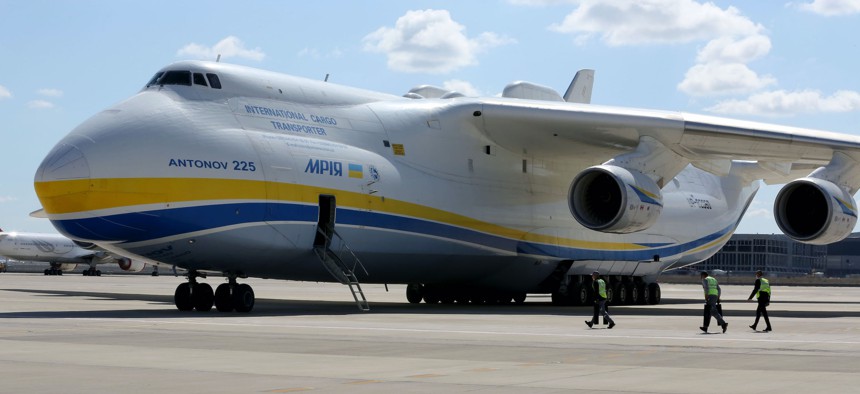
The An-225 in Turkey, Oct. 5, 2021. Dia Images via Getty Images / Ugur Can
Defense Business Brief: Defense spending expected to rise in response to Russian invasion; General pushes for new ICBMs; Carlisle to leave NDIA; and a bit more.
It’s now been more than a week since Russia invaded Ukraine, and the international community is sending weapons and aid. There are also thousands of NATO troops along Russia’s border with eastern Europe. Germany and France each said they would boost defense spending—the United States is expected to do the same.
Arms to Ukraine. Here’s a pretty comprehensive list from the Forum on the Arms Trade of the recent weapon transfers to Ukraine. Sanctions have been levied on Moscow as the U.S. and Europe try to inflict financial repercussions on Russia’s economy.
Among the wreckage from the Russian shelling of Ukraine, the Antonov An-225, which was the world’s largest cargo plane. Pictures show the six-engine Mriya, which means “dream,” in pieces. Antonov Airlines used the plane to fly cargo loads up to 250 tons that were too heavy or didn’t fit in smaller, more widely manufactured aircraft.
Originally built to carry the Buran—the Soviet space shuttle that never flew—the An-225 was a favorite of #AvGeeks. Crowds would routinely gather to get a glimpse of the plane’s take offs and landings at airports around the world.
In 2016, China and Antonov announced a deal to build a second An-225, but that deal appears to have fallen apart prior to the original plane’s destruction. A partially-built An-225 had collected dust for more than 20 years in a Ukrainian hangar. There’s no word if the partially built An-225 was also destroyed. Last year, the Kyiv Post reported that Ukraine was seeking foreign investment to finish building the second plane.
Far from Ukraine, in Orlando, Florida, the Air Force Association’s Warfare Symposium is wrapping up. Among the highlights, Gen. Anthony Cotton, the head of Air Force Global Strike Command, let his feelings be known about some characterizations of the Ground Based Strategic Deterrent, or GBSD—a new nuclear-tipped intercontinental ballistic missile that’s supposed to replace the Cold War-era Minuteman III.
“What I find that's interesting in the conversation about GBSD, we're five years into the program of record,” Cotton said during a Thursday session. “So let's stop talking about it like we're trying to figure out if we're going to turn it into a program of record. It is a program of record, it is the system that we need to replace the Minuteman weapon system.”
GBSD, which is expected to cost taxpayers about $100 billion to develop and buy, is often a target of lawmakers. The Air Force chose Northrop Grumman to build the missile after Boeing dropped out of the contest saying the Air Force bidding parameters favored Northrop.
The first of six B-21 bombers under construction is moving closer to its first flight and has entered a “calibration facility,” Air Force Magazine reports. One more thing about the B-21: Cotton, who oversees the Air Force’s nuclear arsenal, said the stealth bomber “is a penetrating and daily flier that we have to have.” The key term there is “daily flier,” since military aircraft, especially stealth ones, need routine maintenance that limit their ability to fly every day like commercial airliners.
Drone maker General Atomics unveiled Gambit, a new pilotless aircraft that the company is pitching for the Air Force’s Off-Board Sensing Station program,
The White House has finally nominated Bill LaPlante to be the Pentagon’s acquisition chief. The nomination came 90 days after the Biden administration said it would nominate LaPlante for the role. Andrew Hunter, the Air Force’s acquisition chief, has been filling in. Here’s some background on LaPlante.
Jim Inhofe, R-Okla., the top Republican on the Senate Armed Services Committee, is resigning from Congress in Jan. 2023, setting up a special election for his seat larter this year.
Lastly, Herbert “Hawk” Carlisle, the CEO of the National Defense Industrial Association, is stepping down after nearly five years on the job. An NDIA statement said a search to replace the retired Air Force general is expected to conclude before April 1, when Carlisle is scheduled to leave.
Next week: Mark your calendars for March 9, when Jim McAleese’s annual “Defense Programs” conference is back with in-person attendance. Speakers include all three service secretaries, five of the Joint Chiefs, and many other senior Pentagon officials and members of Congress. More info is here.
 From Defense One
From Defense One
Russia's Invasion Will Boost 2023 Defense Budget, Top Democrat Says // Jacqueline Feldscherand Marcus Weisgerber
Rep. Adam Smith: Putin's war "fundamentally altered what our national security posture" needs to be.
Russia Banned from 2022 Farnborough Air Show // Marcus Weisgerber
The July trade show is the year's biggest for European manufacturers and customers of airliners and military aircraft.
Here's Why a Ukraine No-Fly Zone's a No-Go // Marcus Weisgerberand Tara Copp
NATO officials say it's off the table, but there could be a "nuanced option."
Can Ukraine Really Use Donated Fighter Jets? That Depends // Marcus Weisgerber
After EU says it will send some aircraft to Ukraine, a retired U.S. fighter chief explains how that might work.
Germany Pledges Defense Spending Boost as EU Vows to Send Arms to Ukraine // Marcus Weisgerber
Both developments are big changes.
Air Force Special Operations Looks To Reinvent Itself On the Cheap // Patrick Tucker
Cargo planes that drop cruise missiles from pallets and land on water show how air special operators are trying to trick out what they've already got on the tarmac.
Send in the Quadcopters: Arm Ukrainian Citizens with Simple Drones // Zak Kallenborn
Ukrainians are already using consumer-grade drones to spot Russian forces. We should send more of them.
Where Are Russia's Drones? // Samuel Bendett
The Ukraine invasion offers scant evidence of the Russian military's hard-won prowess with unmanned aircraft.
NEXT STORY: Russia Banned from 2022 Farnborough Air Show




